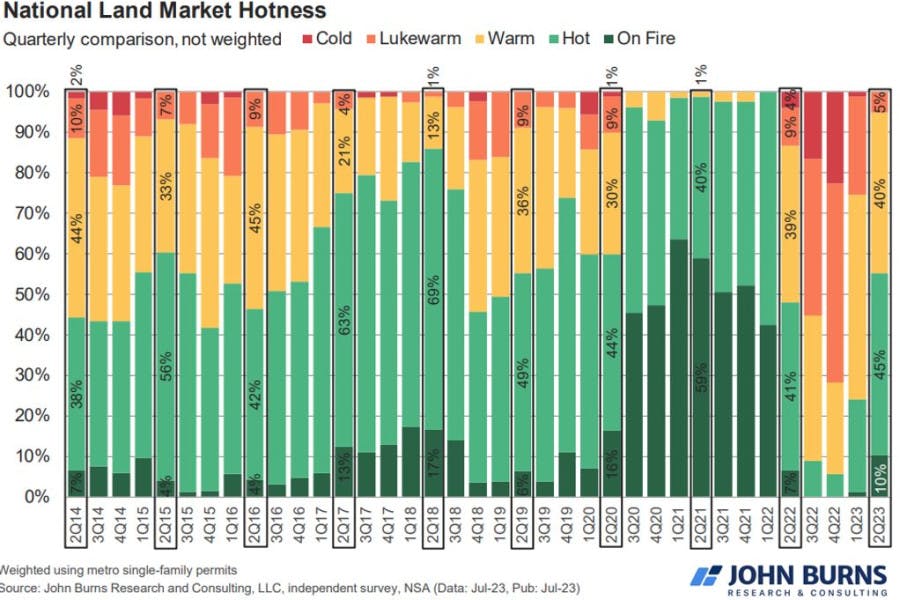Real Estate News
More than half of the land brokers in a recent survey said the national land market is “hot” or “on fire.”
Key points:
- A survey by John Burns Research and Consulting found that the land market in Q2 was the hottest it’s been in more than a year.
- Big homebuilders and single-family rental giants are driving much of this new residential development.
- The temperature of the land market will remain “fairly solid,” researcher Jody Khan said, particularly as existing-home inventory remains tight.
The market for developable land is red hot once again after cooling over the past year. Interest in land deals has risen quickly to a level not seen since early 2022, a survey by John Burns Research and Consulting concluded.
Forty-five percent of the 78 land brokers surveyed in July said the Q2 market for land was “hot” while another 10% indicated that the market was “on fire.” In the prior quarter, only about 25% of the brokers surveyed said the market was either hot or on fire. Overall sentiment around land deals bottomed out in the fourth quarter of last year, when the percentage of “hot” ratings fell into the single digits.

The rapidly rising sentiment and land deal activity is largely due to a combination of an extremely tight existing home market and builders looking to “reload” and get new developments in the pipeline, John Burns researcher Jody Kahn told Real Estate News.
“We are preparing for a strong fourth quarter of this year, because we don’t think that the resale market will show improvement, and the builders are positioning to take advantage of their ability to add supply,” she said.
But it’s not just major homebuilders who are seeking land. The single-family rental market is another big driver of the recent upswing in national land market hotness, she added.
The Northeast and SoCal are feeling the heat
Supply is driving regional differences in the land market. According to Kahn, the Northeast is the hottest region for land deals, followed by Southern California, the Southeast, and Northern California. Meanwhile, Texas, Florida and the Midwest have all cooled.
In the Northeast, major urban centers are densely populated and aren’t as conducive to suburban sprawl like Phoenix, Las Vegas and other growing metros in the West and Southwest, Khan said. Simply put, “the Northeast doesn’t have as much supply,” she explained, adding that “it’s an area where there’s just not a lot of land available close to jobs.”
And then there are differences within the regions themselves. While the Midwest has not seen as much demand for new construction and new land deals as other parts of the country, Indianapolis stands out with its strong market for new homes. Meanwhile, Cleveland is one of the coolest markets for new homes.
Buyers turning to new homes in the face of stiff competition for resales
Builders are meeting the moment by adding new inventory in a market that has been stymied by a lack of existing homes for sale. And agents whose clients are again losing out in bidding wars are looking at new construction as a real means to an end, Khan suggested.
“The agents who we survey are seeing in many cases after several failed attempts of their buyers making offers on resales and not getting it, are taking them over to the new home segment,” she said.
“If there’s nothing for sale and somebody has a family event happening, like they’re getting married, they’re having their second child, or they’re going to be taking care of a senior parent at home — these drivers are still creating demand,” she added.
And with few signs that the supply of existing homes will increase meaningfully in the near term, builders remain in a great position.
“We’re going to continue to see this hotness rating be fairly solid because anytime the builders are building homes, they’re running through what’s in their portfolio and at some point they have to reload and that’s what’s driving this,” Khan said.
